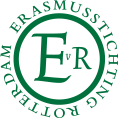Poem
Tom Van de Voorde
Triglav
From time to time I come up with a new hobbyto keep myself sweet with for a while.
For example, last year I started collecting
photographs of mountains.
I can spend hours online
foraging around for beautiful images.
The best finds I save in a folder
accessible through a shortcut on my desktop.
I follow a number of self-imposed criteria
to constrain my collection somewhat.
For instance, none of the photographs can have people
in them (genuinely stress-free mothers,
absently grinning fathers, silly kids in stupid clothes
all make me linger just a little too long
on the hopeless happiness of the family getaway,
not to mention the summers
of my own youth): other than that
the pictures must be of above
the treeline, preferably without snow,
just rocks and rabble; if possible old or at least
old-looking photographs,
black & white, if need be, sepia.
For specific reasons my collection consists
predominantly of images of one particular mountain:
the Triglav, a 2864 meter high sublimity
on the Slovene side of the Julian Alps.
To date I have collected 1623 of them
and have decided to stop at 2864.
While indulging in this hobby of mine
I listen to the music of composers
who have dedicated work to mountains:
Rimsky-Korsakov, Mussorgsky, Liszt,
or sometimes one of those Scandinavians
whose name escapes me just now.
It’s always symphonic music,
rarely a string quartet, piano sonata
or music composed for cello, clarinet
or another such rarefied sounding wind-instrument.
I give all my photos a name;
a little like Native Indians do
but applied to mountains in this case,
and by extension, mountaineering.
I find inspiration in a book about knots:
‘Grey-without-sun.jpg’, ‘Strong-hand.jpg’,
‘Probably-the-morning.jpg’,
‘Monkey-fist.jpg’, ‘Simple-simon.jpg’. That’s
really all I do with my collection.
Moving forward however, I’d like to
become more competent at recognising
my beloved mountain. The Triglav
in frontal view, in rear aspect, the Triglav
in profile, from all four corners of the world ,
the Triglav – and why not – as seen from above.
All proud aspects and angles of the mountain,
from the most notorious to the most adventurous
climbing trails and footpaths, like the ones in
a precariously dangerous photograph, taken from
a courageous angle on a cloudy or rained on day;
a failed shot for the amateur photographer
but all the more exciting for the mountain-devotee.
I want to be able to correctly identify the mountain
under all these circumstances, similar to how a cat
can recognise her young, a whisker removed
from being suffocated in a burlap sack,
but instead adopted by an ex-colleague
with whom you’re no longer in touch
because you never really clicked with
her new boyfriend,
but who you think of from time to time,
because she gave you that vase
perched on top of the grey-green sideboard
in the hallway,
where you leave your car keys
when you get home in the evening
or in the mornings before work
underneath the mirror
in which you check your tie
while thinking, “Why
hasn’t that vase ever fallen off?”
Like that, but not quite,
I intend to recognise
the Triglav,
and to exclaim in a loud voice,
“Hey, that’s Triglav,”
as if bumping into an old friend
on a Sunday afternoon, when,
watching a cross-country bike rally on TV
I want to shout out loudly,
at no one in particular,
but certainly not at my girlfriend,
who is out, or maybe in,
but in any case hears nothing
of my plans to climb
the Triglav one day.
© Translation: 2017, Astrid Alben
Triglav
Triglav
Af en toe verzin ik een nieuwe hobbywaarmee ik mezelf een tijdje zoet hou.
Zo begon ik vorig jaar met de aanleg
van een verzameling foto's van bergen.
Ik struin soms urenlang het internet af
op zoek naar mooie beelden.
De beste vondsten bewaar ik in een mapje
via een snelkoppeling op mijn desktop.
Om mijn verzameling wat af te bakenen
hanteer ik een aantal criteria. Er mogen
bijvoorbeeld geen mensen in beeld komen
(oprecht ontspannen moeders, afwezig
grijnzende vaders, zielig geklede kinderen
doen me net iets te veel stilstaan
bij het reddeloze geluk van gezinsvakanties,
om maar te zwijgen van de zomers
van mijn eigen jeugd); daarnaast
moeten de foto's boven de boomgrens
zijn genomen, het liefst zonder sneeuw,
enkel rotsen; indien mogelijk oude
of op zijn minst oud lijkende foto's,
zwartwit, desnoods sepia.
Om bepaalde redenen bevat mijn verzameling
vooral beelden van één specifieke berg:
de Triglav, een 2864 meter hoge verhevenheid
in het Sloveense deel van de Julische Alpen.
Ik heb er inmiddels 1623 van bewaard
en heb me voorgenomen bij 2864 te stoppen.
Bij het beoefenen van mijn hobby
speel ik vaak muziek van componisten
die werken aan bergen hebben opgedragen:
Rimsky Korsakov, Mussorgsky, Liszt
soms een of andere Scandinaviër van wie
de naam me nu even niet te binnen schiet.
Het gaat steeds om symfonische muziek,
zelden een strijkkwartet, pianosonate
of een compositie voor cello, klarinet
of eender welk ijl klinkend blaasinstrument.
Ik geef al mijn foto's namen
een beetje zoals de Indianen
maar dan toegepast op bergen
en bij uitbreiding de klimsport.
Inspiratie vind ik in een boek over knopen:
'Grijs-zonder-zon.jpg', 'Stevige-hand.jpg',
'Vermoedelijk-'s-ochtends.jpg',
'Apenvuist.jpg', 'Simpele-simon.jpg'. Meer
doe ik eigenlijk niet met mijn verzameling.
In de toekomst zou ik me echter
willen bekwamen in het herkennen
van mijn geliefde berg. De Triglav
in voor- of achteraanzicht, de Triglav
in zijaanzicht, vanuit elk van de vier windstreken,
de Triglav in – waarom niet – bovenaanzicht.
Alle heldhaftige hoeken en kanten van de berg,
van de beruchtste tot de meest avontuurlijke klim-
en wandelpaden, zoals je soms ziet op een net
iets te gevaarlijk genomen foto, op een bewolkte
of uitgeregende dag, vanuit een moedige hoek,
mislukt voor de amateurfotograaf
maar des te opwindender voor de bergofiel.
In al die omstandigheden wil ik de berg
herkennen, een beetje zoals een kat
haar jongen herkent, net niet
gesmoord in de jutezak,
maar geadopteerd door een ex-collega
met wie je geen contact meer hebt
omdat het nooit klikte
met haar nieuwe vriend,
maar aan wie je soms denkt,
omdat ze de vaas gaf
die op de grijsgroene kast staat
in de inkomhal,
waar je je autosleutels naast legt
's avonds bij het thuiskomen
of 's ochtends voor je gaat werken
onder de spiegel
waarin je je stropdas controleert
terwijl je denkt 'Waarom
is die vaas nooit gevallen?'.
Op een gelijkaardige manier
maar dan anders
neem ik me voor
de Triglav te herkennen,
en dan luid te roepen
'Hé daar heb je Triglav'
alsof je een oude vriend ziet staan,
langs de weg op zondagmiddag,
in een veldkoersprogramma.
Ik wil dan heel luid roepen
tegen niemand in het bijzonder,
zeker niet tegen mijn vriendin,
die niet thuis is, of misschien wel,
maar in dat geval niets hoort
over mijn plan om op een dag
de Triglav te beklimmen.
© 2017, Tom Van de Voorde
From: Zwembad de verbeelding
Publisher: Poëziecentrum, Gent
From: Zwembad de verbeelding
Publisher: Poëziecentrum, Gent
Poems
Poems of Tom Van de Voorde
Close
Triglav
From time to time I come up with a new hobbyto keep myself sweet with for a while.
For example, last year I started collecting
photographs of mountains.
I can spend hours online
foraging around for beautiful images.
The best finds I save in a folder
accessible through a shortcut on my desktop.
I follow a number of self-imposed criteria
to constrain my collection somewhat.
For instance, none of the photographs can have people
in them (genuinely stress-free mothers,
absently grinning fathers, silly kids in stupid clothes
all make me linger just a little too long
on the hopeless happiness of the family getaway,
not to mention the summers
of my own youth): other than that
the pictures must be of above
the treeline, preferably without snow,
just rocks and rabble; if possible old or at least
old-looking photographs,
black & white, if need be, sepia.
For specific reasons my collection consists
predominantly of images of one particular mountain:
the Triglav, a 2864 meter high sublimity
on the Slovene side of the Julian Alps.
To date I have collected 1623 of them
and have decided to stop at 2864.
While indulging in this hobby of mine
I listen to the music of composers
who have dedicated work to mountains:
Rimsky-Korsakov, Mussorgsky, Liszt,
or sometimes one of those Scandinavians
whose name escapes me just now.
It’s always symphonic music,
rarely a string quartet, piano sonata
or music composed for cello, clarinet
or another such rarefied sounding wind-instrument.
I give all my photos a name;
a little like Native Indians do
but applied to mountains in this case,
and by extension, mountaineering.
I find inspiration in a book about knots:
‘Grey-without-sun.jpg’, ‘Strong-hand.jpg’,
‘Probably-the-morning.jpg’,
‘Monkey-fist.jpg’, ‘Simple-simon.jpg’. That’s
really all I do with my collection.
Moving forward however, I’d like to
become more competent at recognising
my beloved mountain. The Triglav
in frontal view, in rear aspect, the Triglav
in profile, from all four corners of the world ,
the Triglav – and why not – as seen from above.
All proud aspects and angles of the mountain,
from the most notorious to the most adventurous
climbing trails and footpaths, like the ones in
a precariously dangerous photograph, taken from
a courageous angle on a cloudy or rained on day;
a failed shot for the amateur photographer
but all the more exciting for the mountain-devotee.
I want to be able to correctly identify the mountain
under all these circumstances, similar to how a cat
can recognise her young, a whisker removed
from being suffocated in a burlap sack,
but instead adopted by an ex-colleague
with whom you’re no longer in touch
because you never really clicked with
her new boyfriend,
but who you think of from time to time,
because she gave you that vase
perched on top of the grey-green sideboard
in the hallway,
where you leave your car keys
when you get home in the evening
or in the mornings before work
underneath the mirror
in which you check your tie
while thinking, “Why
hasn’t that vase ever fallen off?”
Like that, but not quite,
I intend to recognise
the Triglav,
and to exclaim in a loud voice,
“Hey, that’s Triglav,”
as if bumping into an old friend
on a Sunday afternoon, when,
watching a cross-country bike rally on TV
I want to shout out loudly,
at no one in particular,
but certainly not at my girlfriend,
who is out, or maybe in,
but in any case hears nothing
of my plans to climb
the Triglav one day.
© 2017, Astrid Alben
From: Zwembad de verbeelding
From: Zwembad de verbeelding
Triglav
From time to time I come up with a new hobbyto keep myself sweet with for a while.
For example, last year I started collecting
photographs of mountains.
I can spend hours online
foraging around for beautiful images.
The best finds I save in a folder
accessible through a shortcut on my desktop.
I follow a number of self-imposed criteria
to constrain my collection somewhat.
For instance, none of the photographs can have people
in them (genuinely stress-free mothers,
absently grinning fathers, silly kids in stupid clothes
all make me linger just a little too long
on the hopeless happiness of the family getaway,
not to mention the summers
of my own youth): other than that
the pictures must be of above
the treeline, preferably without snow,
just rocks and rabble; if possible old or at least
old-looking photographs,
black & white, if need be, sepia.
For specific reasons my collection consists
predominantly of images of one particular mountain:
the Triglav, a 2864 meter high sublimity
on the Slovene side of the Julian Alps.
To date I have collected 1623 of them
and have decided to stop at 2864.
While indulging in this hobby of mine
I listen to the music of composers
who have dedicated work to mountains:
Rimsky-Korsakov, Mussorgsky, Liszt,
or sometimes one of those Scandinavians
whose name escapes me just now.
It’s always symphonic music,
rarely a string quartet, piano sonata
or music composed for cello, clarinet
or another such rarefied sounding wind-instrument.
I give all my photos a name;
a little like Native Indians do
but applied to mountains in this case,
and by extension, mountaineering.
I find inspiration in a book about knots:
‘Grey-without-sun.jpg’, ‘Strong-hand.jpg’,
‘Probably-the-morning.jpg’,
‘Monkey-fist.jpg’, ‘Simple-simon.jpg’. That’s
really all I do with my collection.
Moving forward however, I’d like to
become more competent at recognising
my beloved mountain. The Triglav
in frontal view, in rear aspect, the Triglav
in profile, from all four corners of the world ,
the Triglav – and why not – as seen from above.
All proud aspects and angles of the mountain,
from the most notorious to the most adventurous
climbing trails and footpaths, like the ones in
a precariously dangerous photograph, taken from
a courageous angle on a cloudy or rained on day;
a failed shot for the amateur photographer
but all the more exciting for the mountain-devotee.
I want to be able to correctly identify the mountain
under all these circumstances, similar to how a cat
can recognise her young, a whisker removed
from being suffocated in a burlap sack,
but instead adopted by an ex-colleague
with whom you’re no longer in touch
because you never really clicked with
her new boyfriend,
but who you think of from time to time,
because she gave you that vase
perched on top of the grey-green sideboard
in the hallway,
where you leave your car keys
when you get home in the evening
or in the mornings before work
underneath the mirror
in which you check your tie
while thinking, “Why
hasn’t that vase ever fallen off?”
Like that, but not quite,
I intend to recognise
the Triglav,
and to exclaim in a loud voice,
“Hey, that’s Triglav,”
as if bumping into an old friend
on a Sunday afternoon, when,
watching a cross-country bike rally on TV
I want to shout out loudly,
at no one in particular,
but certainly not at my girlfriend,
who is out, or maybe in,
but in any case hears nothing
of my plans to climb
the Triglav one day.
© 2017, Astrid Alben
Sponsors

























